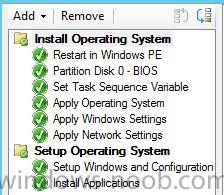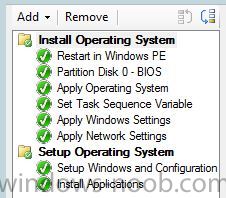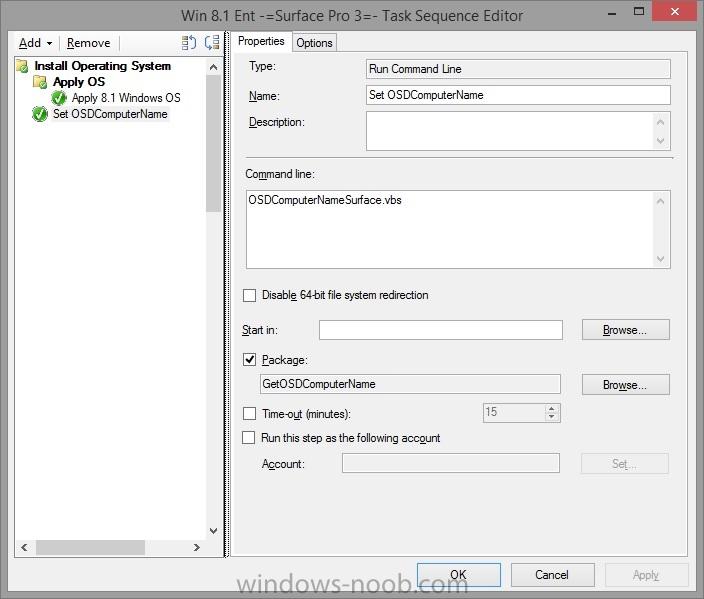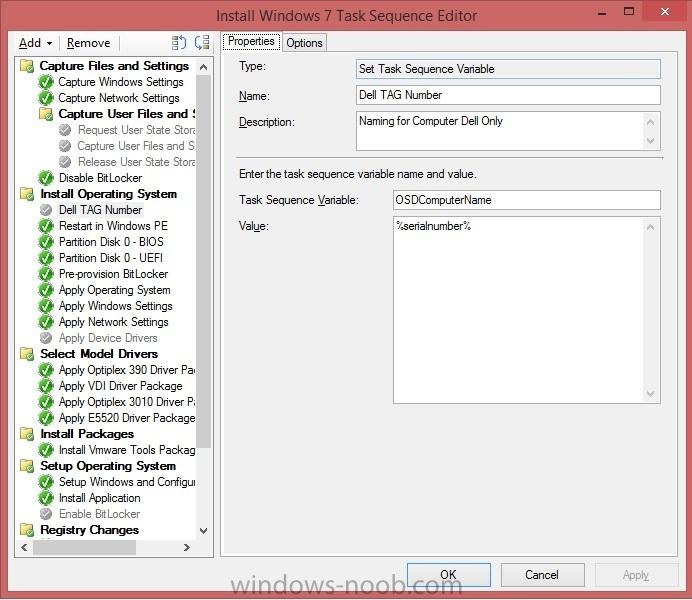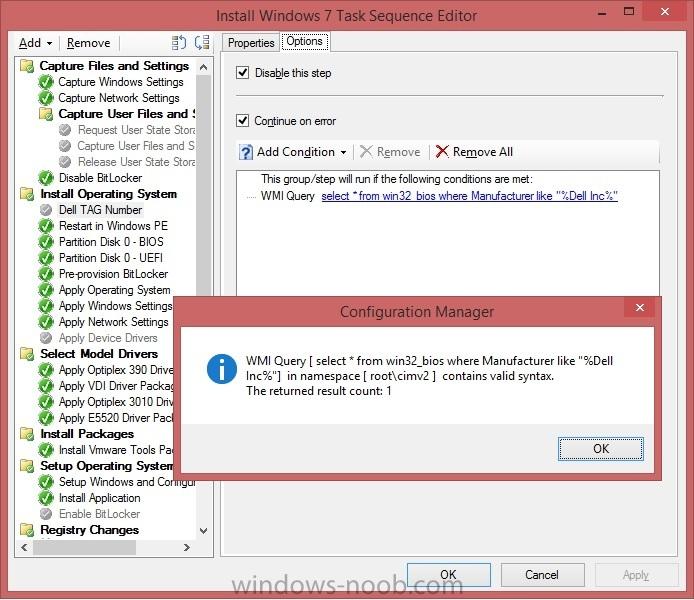Search the Community
Showing results for tags 'OSDcomputername'.
-
Guys Been building Windows 10 1709 for about a year all fine... We are starting to build 1809 and all works except the TS/Naming now seems to ignore the Collection Variable 'OSDComputerName' I have both 1709 and 1809 images, both building from the same 'All Unknown Computers' collection, the 1709 works the 1809 does not. the 1809 uses a copy of the TS from 1709 with just the WIM changed. Any ideas? thanks
- 1 reply
-
- osdcomputername
- task sequence
-
(and 2 more)
Tagged with:
-
I currently have multiple customsettings.ini files that assign computer names based on location + asset tag. I'm wondering if there is a way to have only one file that can do the same when selecting the location from a front end HTA. PS: I can't use the default gateway as the computers are imaged from the same location. Thanks,
- 1 reply
-
- customsettings
- sccm
-
(and 2 more)
Tagged with:
-
SCCM 2012 R2 SP1 CU3 (5.0.8239.1403) Windows 10 Enterprise 1607 x64 CB (KMS Product Key) I am unable to figure out how to create a task sequence that deploys Win10 using OSDComputerName. Here is what I am doing: Create Hyper-V VM Install Windows 10 Run Windows Update System is NOT joined to a domain Use capture media and import as new OS image Create task sequence; I have tried moving around the 'Set Task Sequence Variable' but nothing seems to work PXE boot and run task sequence Enter something like 'OSDTEST' when prompted for 'OSDComputerName' The result is a system that joins the domain with a name like MININT-XXXXXXX. Other tidbits: There is nothing in the C:\Windows\Panther\Unattend folder. I believe there is supposed to be an Unattend.xml file there. My task sequence includes a few other customizations including installing the SCCM Client and a couple of applications. All of these other things work great. smsts.log
- 6 replies
-
- OSDComputerName
- Windows 10
-
(and 1 more)
Tagged with:
-
Hello all, hopefully you can help solving this issue that's bugging me for quite a time. When we're deploying new computers, or computers that are not in the sccm database, we use the OsdComputername variable to name the computer, it's working well but when I'm looking for the logs in the console under system status> advertisment status the default computer name (minint-xxx) appears in the system column instead of the given name, until the task "Setup windows and ConfigMgr" has completed (and still the new name is displayed only for the "Software Distribution" component. here is a screenshot of what I see, it's not really important for 1 or 2 computer but when we're deploying 100 at the same time it's impossible to troubleshoot. https://skydrive.liv...3E677D04EA!5652 so how could we have the name we had specified in the osdcomputername variable at the start of the task sequence displayed in the "system" name in the status messages report? I know there is the the _SMSTSMachineName buit in variable but i'm sure how I can use that in my task sequence. thanks
- 1 reply
-
- sccm
- task sequence
-
(and 4 more)
Tagged with:
-
Just thought I'd share a script I wrote this morning. I currently have a task sequence that builds various devices and takes the OSDComputerName variable from the Asset Tag BIOS field. The Surface Pro 3 works a little different, in that you can't set this field directly from the BIOS, you need to set it using a CLI utility (available here - http://www.microsoft.com/en-us/download/details.aspx?id=44076).This usually means booting a brand new device, going through the OOBE stuff, running the CLI utility, then restarting into PXE and continuing with imaging as normal. The below .vbs script first checks if there is an existing asset tag entered, and if not prompts the user to enter a machine name, which it then uses in the Task Sequence and sets the tag locally using the utility, so the next time the device is built it just takes the tag straight from the BIOS. Dim objWMIService Dim colItems Dim objSMSEnv Dim strNewName Dim WshShell Dim strCurDir Set objWMIService = GetObject("winmgmts:\\.\root\CIMV2") Set colItems = objWMIService.ExecQuery("SELECT * FROM Win32_SystemEnclosure") 'Get the current Asset Tag For Each objItem In colItems 'Remove all beginning, trailing and containing spaces and switch to uppercase strNewName = objItem.SMBIOSAssetTag Next wscript.echo "Currently using " & strNewName & " as OSDComputerName" If left(strNewName,4) <> "SomeString" Then Do While X = 0 strNewName = InputBox ("Please enter a machine name i.e. HP-XXXXXX","Enter Machine Name...") If strNewName = "" Then Wscript.Echo "You must enter a machine name." Else Set WshShell = WScript.CreateObject("WScript.Shell") strCurDir = WshShell.CurrentDirectory WshShell.Run strCurDir & "\AssetTag -s " & UCase(strNewName), 0 wscript.echo "Currently using " & strNewName & " as OSDComputerName Set objSMSEnv = CreateObject("Microsoft.SMS.TSEnvironment") wscript.echo "Set Task Sequence variable OSDComputerName to: " & strNewName objSMSEnv("OSDComputerName") = UCase(strNewName) Exit Do End If Loop Else Wscript.Echo strNewName Set objSMSEnv = CreateObject("Microsoft.SMS.TSEnvironment") wscript.echo "Set Task Sequence variable OSDComputerName to: " & strNewName objSMSEnv("OSDComputerName") = UCase(strNewName) End If Set WshShell = Nothing I deployed it by having AssetTag.exe and script file in a folder on my SCCM OSD scripts directory, then created a simple package without program and pointed at this location. After distributing to my local DPs I then created a Run Command Line task sequence item and added the name of the script file into the Command Line area, making sure to reference the package containing the script.
-
- surface pro 3
- OSDcomputername
-
(and 3 more)
Tagged with:
-
I have been wrestling with for sometime. SCCM 2012 sp1 MDT 2012 Integration I am using UDI Wizard along wth customsettings.ini Goal: I want to have users get the UDI wizard and choose the settings like what OU they want the computer to go into during the task sequence. I then want the computer name to be based on the OU that has been chosen eg: If the user picks Eastern Regions in the UDI Wizard then during the taks sequence the name of the computer will be be based on the OU that the computer is put int for example - EASw7L-%serial% I need help understanding how to setup the variables using OSDDomainOUName if needed and what step to use this in the Join Domain vs Apply Network Settings. We can do a remote connection so you can see whats going on if that will make things easier. Thanks for any help with this!
-
- osdcomputername
- computername
- (and 5 more)
-
SCCM 2012 R2 CU1, using OSD Task Sequence I'm stuck trying to auto-name Lenovo Yoga 2 Pro machines but when I put %serialnumber% in the TS Variable for OSDComputerName, it puts in a different number than is on the bottom of the machine. I want users to easily be able to see the model number that will be the name of the PC. I can find this number by running "wmic baseboard get serialnumber" and it matches what is on the tag, but I can't figure out how to get that into the TS. If someone could provide a simple way to do this or provide any screenshots of the TS item I would be in your debt! I have Dell Latitudes that are naming correctly using the %serialnumber% during the Post Install, after the Gather step. Thanks, Matt
-
- OSD
- Task Sequence
-
(and 1 more)
Tagged with:
-
Hi All, I was wondering if you could help me in renaming PC's during deployment. I am just getting started with SCCM and OSD deployments. I have a basic working deployment that deploys drivers per model using a wmi query to find the model number. My (dell) desktops / laptops will install and join the domain to a specified OU. My problem is when i add the OSDcomputername task sequence variable %serialnumber% i get the following error just before it finishes the task sequence. "Windows could not parse or process the unattend answer file for pass [specialize]. The settings specified in the answer file cannot be applied. The error was detected while processing settings for component [Microsoft-Windows-Shell-Setup]." My task sequence settings have been attached if that helps. Enabled it and it breaks things, disabled it and it goes back to working again. 1) Firstly is this the correct way for automating PC renaming during deployment? 2) What are others doing to rename PC's during deployment? I have read a lot of posts on forums regarding this process including scripts etc but i cannot make any of them work via OSD. I have a working powershell script that i can run from the desktop that checks if the serial number (TAG) matches the computer name, if it does not it renames the computer to the Serial number (TAG). Then i join the domain but i would like this to be part of the task sequence so we dont have to revisit workstations. If anyone has a working solution for renaming PC's during deployment please let me know. Thanks for reading Regards Dave
- 1 reply
-
- task sequence
- osd
-
(and 5 more)
Tagged with:
-
Hello everyone , Some time ago we released console extensions for computer autonaming with desired prefix. Based on feedback we have received we are happy to announce that version 2.0 of our console extensions is available. Detailed information can be found on our website For those who would like to use that style of computer autonaming - but necessarly extend console of SCCM you can use our webservices - detailed information here Sorry we didn't make for Xmas but we are still hoping you will find this a great extension to power of SCCM Thanks Rafal
-
- OSDComputerName
- Autonaming
-
(and 4 more)
Tagged with:
-
Hello everyone, Here is my situation. I have a Windows XP in DOM A and SCCM A on which I am advertising a task sequence to deploy W7 and join DOM B with SCCM B. The migration/deployment scenario works great, no problem on that. My first steps that are done online (not in WinPE) are the following on the XP machine: -Backup of user settings with USMT -Backup of user data with Robocopy -Change the name of the computer locally/AD with a vbscript that also set the OSDComputerName variable with the new value -Restart on Windows (to validate the renaming) -Restart in WinPE and go on with the classic deployment (Format, dl of the .wim ...) The thing is that everytime, once the machine is in the new AD and SCCM it still has its old computername. Even though the script changed successfully the name of the computer in the AD and locally of the XP. So I am wondering if this is possible to set the OSDComputerName out of WinPE? And if yes am I doing it right? Here is the part of my script where I set the variable: dim env SET env = CreateObject("Microsoft.SMS.TSEnvironment") env("OSDComputerName") = NewComputerName Where the variable NewComputerName is a variable set before with the new computer name (and it works as it changes the value in the AD). The script is run with an account that as domain admin privileges in DOM A and full access on a DFS in DOM B where the script and a csv file containing all the new values are stored. So, what is wrong?? THank you a lot, I have been trying to fix this for days !!
-
- SCCM 2007
- OSDComputerName
-
(and 3 more)
Tagged with:


